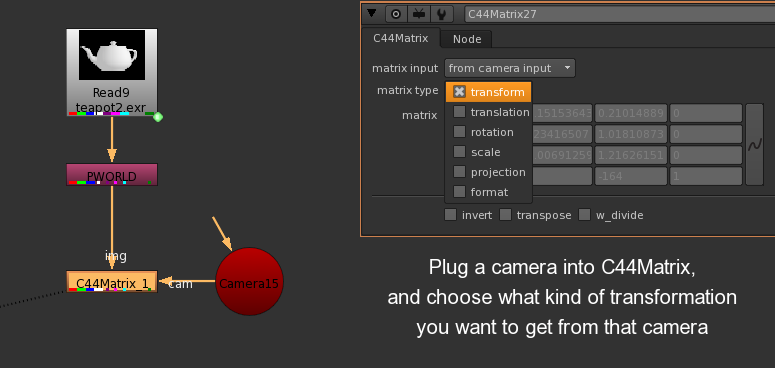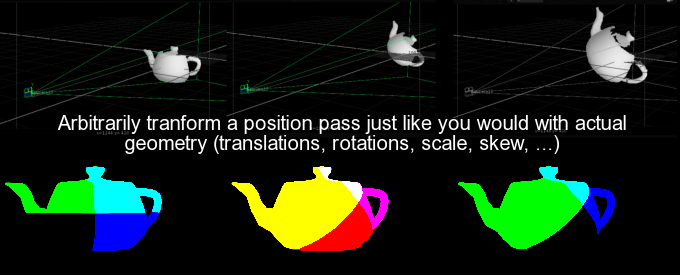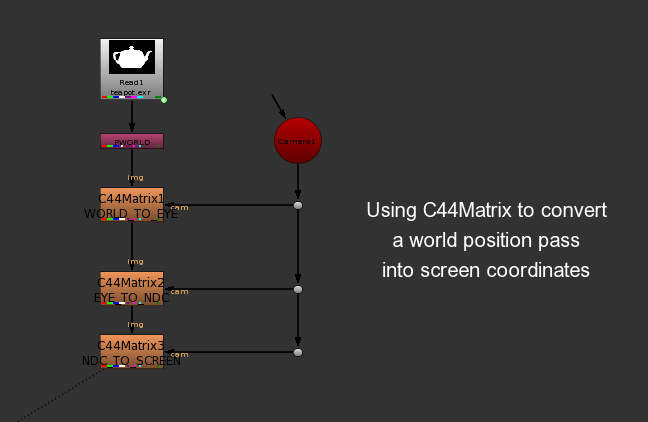C44Matrix is an extended version of ColorMatrix that allows to use 4x4 matrices to transform color data. Additionally, it provides an optional Camera input to automatically get a transformation or a projection matrix from it.
C44Matrix
First submitted: 13 December 2013
Author: Ivan Busquets
Compatible Nuke versions: 8.0 or later
Compatibility: Linux 64, Mac 64, Windows 64, Source
1. Description
C44Matrix is basically an extended version of Nuke's ColorMatrix, but instead of using a 3x3 matrix, it allows to use a 4x4 matrix to transform color data.
Additionally, it provides an optional Camera input to automatically get a transformation or a projection matrix from it.
The main goal of C44Matrix is to make it easier for users to perform transformations on pixels containing position data, such as a world position pass. From arbitrary transformations, to converting between different coordinate systems (world space, camera space, NDC, etc), C44Matrix should make things a little easier by not having to resort to complex expressions and multiple nodes to apply a 4x4 matrix to pixels.
2. Workflow
C44Matrix will apply its transformation to pixels in the RGBA channels. R,G,B and A will be used respectively as the X, Y, Z and W components of a vector to which we want to apply the transformation. Most of the times, you'll want to make sure you have a solid alpha channel (A=1) to make sure you get the right results.
There's 2 modes of operation:
- Manual input:
This works the same way as the ColorMatrix node, but with a 4x4 grid instead. With this mode, you would manually enter (or expression-link) the values of a 4x4 matrix you might have obtained from a Python script, or from the metadata of a render, etc.
- From Camera input:
In this mode, the 4x4 grid is automatically filled in with a transformation matrix taken from the connected camera.
You can choose between the following matrices:
- Transform: Takes the full transformation matrix from the camera. This includes translations, rotations, and scaling. You can use this matrix to go from WORLD SPACE to CAMERA SPACE and viceversa
- Translation: Like transform, but only taking the translation component
- Rotation: Like transform, but only taking the rotation component
- Scale: Like transform, but only taking the scaling component
- Projection: takes the projection matrix from the camera. This accounts for all the parameters in the projection tab (aperture, focal, win_translate, win_scale, roll). You can use this matrix to go from CAMERA SPACE to NDC and viceversa.
- Format: uses the current format to build a matrix that goes from NDC (-1 to 1) to pixel coordinates for the current format.
For either one of the above methods, there are the following additional options:
- invert: apply the inverse of the matrix that's in the 'matrix' knob.
- transpose: apply the transpose of the matrix that's in the 'matrix' knob. (replace rows with columns)
- w_divide: divide the resulting vector by its W component. You'll usually want to do that when applying a projection matrix.
3. Screenshots



4. Note
This node is mostly intended to make it easier to build gizmos that want to deal with these sort of transformations.
It might be a little bit too cumbersome for direct use (without wrapping it into a more user-friendly gizmo), so if anyone wants to share ideas on how to improve the user experience or the documentation above, all feedback is very welcome.
Comments